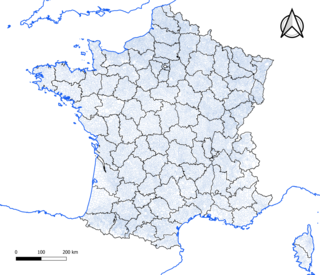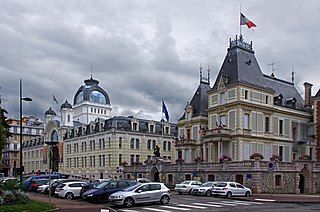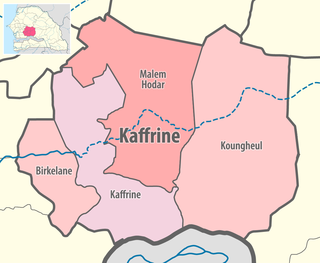
The president of France, officially the president of the French Republic, is the executive head of state of France, and the commander-in-chief of the French Armed Forces. As the presidency is the supreme magistracy of the country, the position is the highest office in France. The powers, functions and duties of prior presidential offices, in addition to their relation with the prime minister and government of France, have over time differed with the various constitutional documents since the Second Republic.

France is divided into eighteen administrative regions, of which thirteen are located in metropolitan France, while the other five are overseas regions.

Devolution is the statutory delegation of powers from the central government of a sovereign state to govern at a subnational level, such as a regional or local level. It is a form of administrative decentralization. Devolved territories have the power to make legislation relevant to the area, thus granting them a higher level of autonomy.

The commune is a level of administrative division in the French Republic. French communes are analogous to civil townships and incorporated municipalities in the United States and Canada, Gemeinden in Germany, comuni in Italy, or municipios in Spain. The UK equivalent are civil parishes. Communes are based on historical geographic communities or villages and are vested with significant powers to manage the populations and land of the geographic area covered. The communes are the fourth-level administrative divisions of France.

Senegal is subdivided into 14 regions, each of which is administered by a Conseil Régional elected by population weight at the arrondissement level. Senegal is further subdivided into 45 departments, 103 arrondissements and by collectivités locales which elect administrative officers. Three of these regions were created on 10 September 2008, when Kaffrine Region was split from Kaolack, Kédougou region was split from Tambacounda, and Sédhiou region was split from Kolda.
A territorial collectivity, or territorial authority, in many francophone countries, is a legal entity governed by public law that exercises within its territory certain powers devolved to it by the State as part of a decentralization process. In France, it also refers to a chartered administrative division of France with recognized governing authority. It is the generic name for any territory with an elective form of local government and local regulatory authority. The nature of a French territorial collectivity is set forth in Article 72 of the Constitution of France (1958), which provides for local autonomy within limits prescribed by law.

An administrative centre is a seat of regional administration or local government, or a county town, or the place where the central administration of a commune is located.
In France, taxation is determined by the yearly budget vote by the French Parliament, which determines which kinds of taxes can be levied and which rates can be applied.

The 14 regions of Senegal are subdivided into 46 departments and 103 arrondissements and by collectivités locales which elect administrative officers.
Senegal is subdivided into four levels of administrative divisions.
Water supply and sanitation in France is universal and of good quality. Salient features of the sector compared to other developed countries are the high degree of private sector participation using concession and lease contracts and the existence of basin agencies that levy fees on utilities in order to finance environmental investments. Water losses in France (26%) are high compared to England (19%) and Germany (7%).

Koungheul is the name of one of 45 departments of Senegal, as well as the name of Koungheul Arrondissement and the commune of Koungheul, the principal settlement of the department.

Niger is governed through a four layer, semi-decentralised series of Administrative divisions. Begun 1992, and finally approved with the formation of the Fifth Republic of Niger on 18 July 1999, Niger has been enacting a plan for Decentralisation of some state powers to local bodies. Prior to the 1999-2006 project, Niger's subdivisions were administered via direct appointment from the central government in Niamey. Beginning with Niger's first municipal elections of 2 February 1999, the nation started electing local officials for the first time. Citizens now elect local committee representatives in each Commune, chosen by subdivisions of the commune: "Quarters" in towns and "Villages" in rural areas, with additional groupings for traditional polities and nomadic populations. These officials choose Mayors, and from them are drawn representatives to the Department level. The Departmental council, Prefect, and representatives to the Regional level are chosen here using the same procedure. The system is repeated a Regional level, with a Regional Prefect, council, and representatives to the High Council of Territorial Collectives. The HCCT has only advisory powers, but its members have some financial, planning, educational and environmental powers. The central government oversees this process through the office of the Minister of State for the Interior, Public Safety and Decentralization.
In France, the versement transport is a hypothecated urban regional payroll tax levied on the total gross salaries of all employees of companies of more than 11 employees, originally intended to raise capital for investment in local public transport infrastructure, but more and more used to cover its operating expenses. The tax is levied on the employer, not the employee directly. The money is directed to the autorité organisatrice de transport urbain, the local government authority responsible for organising public transport.

Municipal elections in France allow the people to elect members of the City Council in each commune. These are called conseillers municipaux. They elect the mayor, who chairs the city council, as well as Deputies to the Mayor. The term of office of councilors, the mayor and his deputies is, in principle, six years.

In France, a municipal council is an elected body of the commune responsible for "executing, in its deliberations, the business of the town" (translated).

In France, a mayor, is chairperson of the municipal council, which organises the work and deliberates on municipal matters. The mayor also has significant powers and their own responsibilities, such as the responsibility for the activities of municipal police and for the management of municipal staff.

The European Collectivity of Alsace is a territorial collectivity in the Alsace region of France. On 1 January 2021, the departments of Bas-Rhin and Haut-Rhin merged into a territorial collectivity but remained part of the region Grand Est. The creation of this new entity was voted by the French Parliament on 25 July 2019 and Law 2019-816 delimiting its powers was promulgated on 2 August 2019.

The Regional Council of Nouvelle-Aquitaine is the deliberative assembly of the French region of Nouvelle-Aquitaine. The regional council is made up of 183 regional councilors elected for 6 years and is chaired by Alain Rousset.
Administrative police in France are French police tasked with preventing disturbances to the ordre public. and ensuring the public peace and preventing crime. Ordre public or public peace in a society includes public tranquility, safety and well-being. Two types of ordre public exist:










